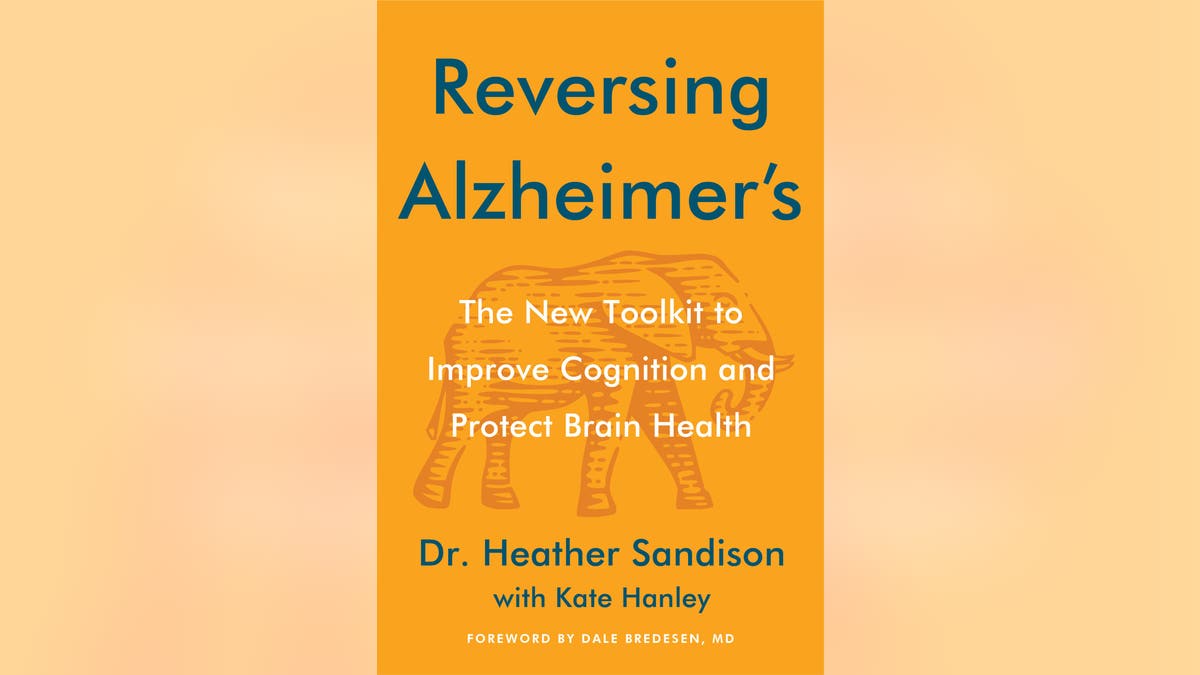Can Alzheimer's disease be reversed?
Dr. Heather Sandison, a renowned expert in Alzheimer disease and dementia-related care, believes reversal is not only possible, but is already happening in several patients.
In her new book “Reversing Alzheimer's: The New Toolkit for Improving Cognition and Protecting Brain Health,” published by HarperCollins on June 11, California-based Sandison offers a step-by-step guide to help Alzheimer's patients. improve your overall brain health.
NEW TREATMENT FOR ALZHEIMER'S ACCELERATES PLAQUE REMOVAL FROM THE BRAIN IN CLINICAL TRIALS
One of the central elements of Sandison's program is a focus on exercise as one of the most important lifestyle factors to prevent and control dementia.
Research has shown that physical activity can reduce the likelihood and progression of Alzheimer's.
Dr. Heather Sandison, left, is a naturopathic doctor specializing in neurocognitive medicine and founder of Solcere Health Clinic, San Diego's leading brain optimization clinic, and Marama, the first residential memory care center that aims to return cognitively impaired residents to an independent life. (Dr. Heather Sandison/iStock)
In the following excerpt, Sandison offers some specific recommendations for the types of exercise that may benefit patients living with the disease.
Read an excerpt from 'Reversing Alzheimer's'
Dr. Heather Sandison: Do you need new motivation to be active? Exercise is medicine for the brain and provides an amazing array of benefits.
Most obviously, exercise increases blood flow throughout the body, including the brain. That means getting your body moving will deliver more oxygen and nutrients to your brain while removing more waste products.
Exercise also strengthens heart and cardiovascular system, which helps improve blood flow even when you're not exercising; It also reduces the risk of arterial plaques that could impair blood flow to the brain and contribute to dementia.
ALL ABOUT ALZHEIMER'S DISEASE: SIGNS, SYMPTOMS AND STAGES
The main reason why exercise is a powerful health protector It is what is known as a hormetic or beneficial stressor.
Basically, when you put your body to the test, the body is forced to consume resources and even your tissues may break down a little. (That's what happens when you lift weights: your muscles tear a little).

Dr. Heather Sandison, an expert in Alzheimer's disease and related dementia care, believes reversal is not only possible but is already happening in multiple patients. (Dr. Heather Sandison)
In that sense, you are introducing stress into your system, but that stress is a force for good, because it causes your body to become more efficient in using its resources and your tissues to grow back even stronger. In other words, exercise makes your body, including your brain, more resilient.
Benefits of exercise several of the fundamental causes of neurological diseases.
Improvement structure increasing your cardiovascular capacity and stimulating circulation, which delivers oxygen and nutrients to the brain.
FOR ALZHEIMER'S PATIENTS, EATING POMEGRANATE COULD HELP RELIEVE SYMPTOMS, STUDY SAYS: 'PROMISING RESULTS'
Is reduced stress in multiple ways: giving you an outlet to let off steam, producing feel-good hormones like endorphins, and reducing stress. stress hormone cortisoland, depending on the type of exercise you choose, getting you outdoors and into nature, which is a known stress reliever.
It can also be social and a great way to spend time with friends or even meet new people, helping to address the loneliness and social isolation that The Lancet lists as one of the modifiable risk factors for Alzheimer's disease.

In her new book “Reversing Alzheimer's: The New Toolkit for Improving Cognition and Protecting Brain Health,” published by HarperCollins on June 11, California-based Sandison offers a step-by-step guide to help Alzheimer's patients improve their overall brain. health. (HarperCollins)
Improvement sleep getting tired
Strengthens immune function, reducing the risk and effects of infection — all those muscle contractions and movements against gravity improve the flow of lymphatic fluid, which releases immune cells and eliminates invading cells.
“Exercise benefits several of the root causes of neurological diseases.”
Promotes detoxboth through increased circulation and through sweating.
Improvement signalingas challenging and strengthening muscles triggers the release of multiple signaling molecules, known as exerkines, which have demonstrated neuroprotective functions.

“The main reason exercise is such a powerful health protector is that it is what is known as a hormetic or beneficial stressor,” Sandison writes in her new book. (Dr. Heather Sandison)
If you do just one thing: Change your current exercise routine in a way that challenges your brain and increases intensity.
If you're a devoted walker, find a new route that includes hills or stairs. If you're willing to try something different, check out a new exercise class you've been meaning to try.
Exercise categories: some familiar, some cutting-edge
There are four types of exercise you want to prioritize. Four may seem like a lot, but they are not mutually exclusive.
You can combine at least two types of exercise in one session: you can turn strength training into cardio by performing your strength moves in high-intensity intervals, or you can make your cardio dual-task by doing something that requires your mental concentration while you move.
Aerobic exercise
Aerobic exercise is what we think of as “cardio”: it gets the heart and blood pumping and includes forms of exercise such as walking, jogging, cycling, dancing and swimming.
Aerobic exercise strengthens the heart, and what is good for the heart is also good for the brain, because the heart sends the blood, oxygen, and nutrients on which its functioning depends to the brain.
EXPERIMENTAL ALZHEIMER'S DRUG GETS APPROVAL FROM FDA ADVISORY PANEL: 'PROGRESS IS HAPPENING'
Your first goal when adding more exercise to your life is to get 150 to 200 minutes of aerobic exercise each week to get your heart rate into the vigorous zone of 70-85% of maximum heart rate.
Listening to your body and adjusting your intensity level based on perceived exertion is one of the best ways to know if you're trying hard enough.
strength training
Strength training, also known as resistance training, is exactly what it sounds like: using weights or other forms of resistance to build muscle tissue.
Building muscle, particularly in the large muscle groups of the legs, hips, and torso, is directly related to brain healthbecause these muscles generate brain-derived neurotrophic factor (BDNF), a “fertilizer” for the brain, telling it to create new neural connections and promoting neuroplasticity.

Alzheimer's patients should aim for at least two strength training sessions per week, says the author of a new book. (iStock)
You want to try to do at least two strength training sessions per week. Strength training doesn't have to involve using standard barbells and doing bodyweight bench presses.
You can use resistance bands, light dumbbells, or even your own body weight for exercises like squats, lunges, and planks.
Even climbing stairs or hills counts as strength and cardio training in one activity, because they increase your heart rate and also keep your leg and hip muscles strong.
Dual task training
This next-level form of exercise combines physical movement with a cognitive challenge. The easiest way to do this is to walk and talk.
What is a cognitive challenge will vary from person to person, but if you are in prevention mode, listening to a foreign language lesson or non-fiction book while walking outside or riding a stationary bike and then pausing the recording to summarize what you just finished to learn every few minutes, it is a good option.
CLICK HERE TO SUBSCRIBE TO OUR HEALTH NEWSLETTER
For some people, going to a Pilates or yoga class or another class where you really have to pay attention to the teacher's directions constitutes double-task training, but not if it's something you've been doing long enough to be able to disconnect.
“Exercise is such a powerful health intervention that if we could suppress it, we could probably get rid of chronic diseases.”
And if you've already started to experience measurable cognitive decline, dual-task training might involve going for a walk while pointing out the names of plants you pass along the way, or having someone ask you about the names of plants. members of your family, or remembering family stories or important dates.
CLICK HERE TO GET THE FOX NEWS APP
Wherever you are, you will want to work at your limit; You can almost feel the wheels in your brain turning to keep you focused.
Contrast oxygen therapy
This relatively unique form of training alternates the amount of oxygen in the air you breathe while you exercise, an approach that stimulates the opening of the smallest blood vessels (known as microvasculature) throughout the body, including the brain, resulting in vastly improved training. blood circulation.
It's similar to going to altitude to train and develop your aerobic capacity, and is incredibly valuable for cognitive function.

“Exercise takes time and effort, but making this activity a regular part of your life addresses so many causal factors of dementia that you can profoundly reduce your risk,” Sandison says in her book. (iStock)
This type of exercise requires specialized equipment. You can purchase the device or find a nearby clinic where you can try it. It requires you to wear a mask attached to a machine while you exercise, and when oxygen saturation is low, it can be intense because you have to work harder to bring in enough air.
In other words, contrast oxygen therapy is not for everyone. But if you're willing and able, it can be a big help.
For more health articles, visit www.foxnews/health
Honestly, exercise is a powerful health intervention that if we could bottle it, we could probably get rid of chronic diseases.
Exercise takes time and effort, but making this activity a regular part of your life addresses so many causal factors of dementia that it can profoundly reduce your risk.
Extracted with permission from the new book, “Reversing Alzheimer's: The New Toolkit to Improve Cognition and Protect Brain Health” (HarperCollins) by Dr. Heather Sandison, copyright © 2024 by Dr. Heather Sandison. All rights reserved.












